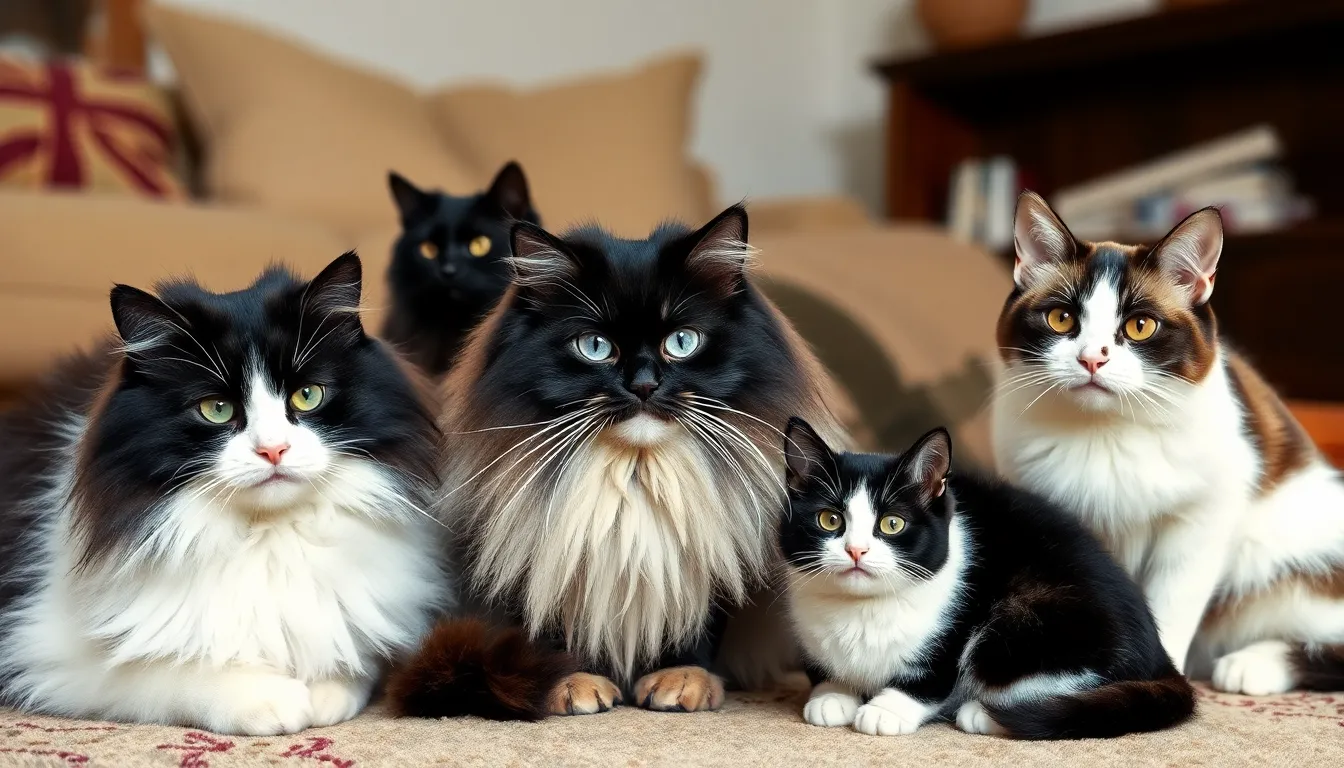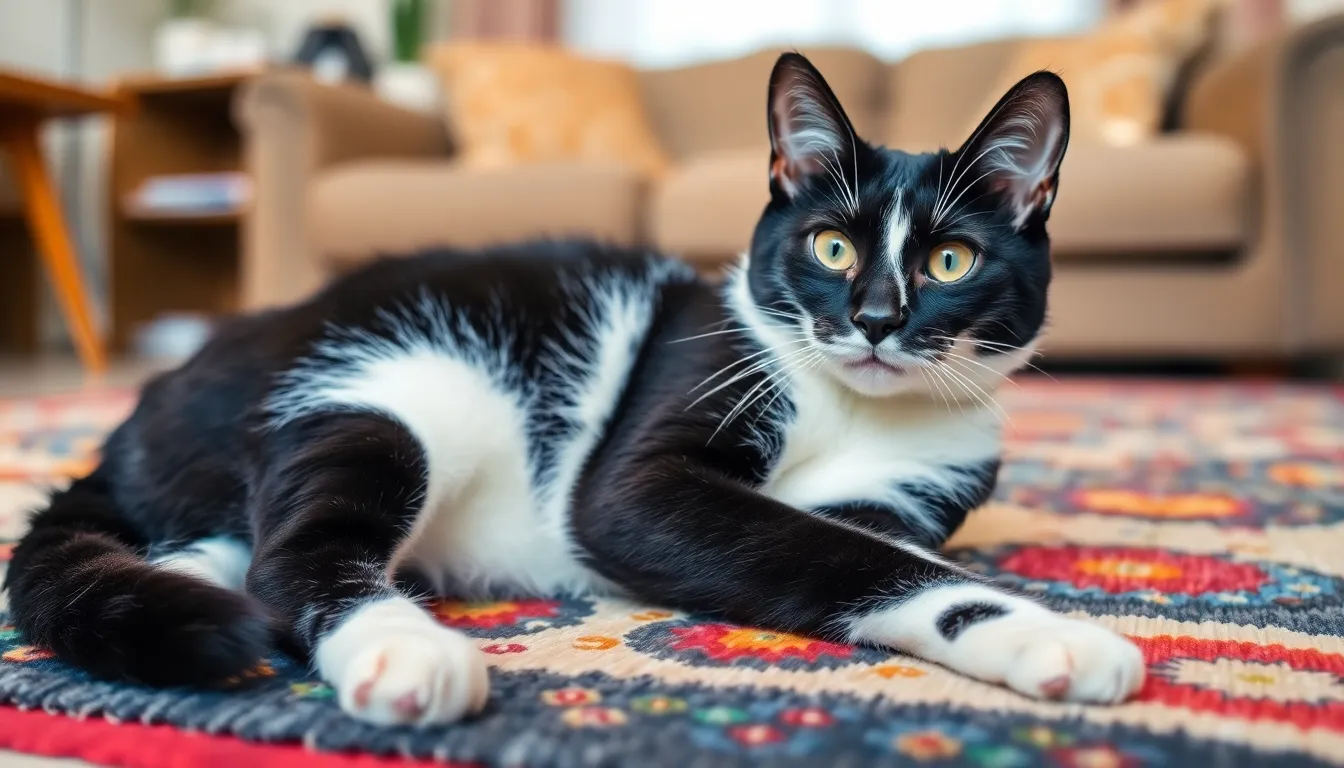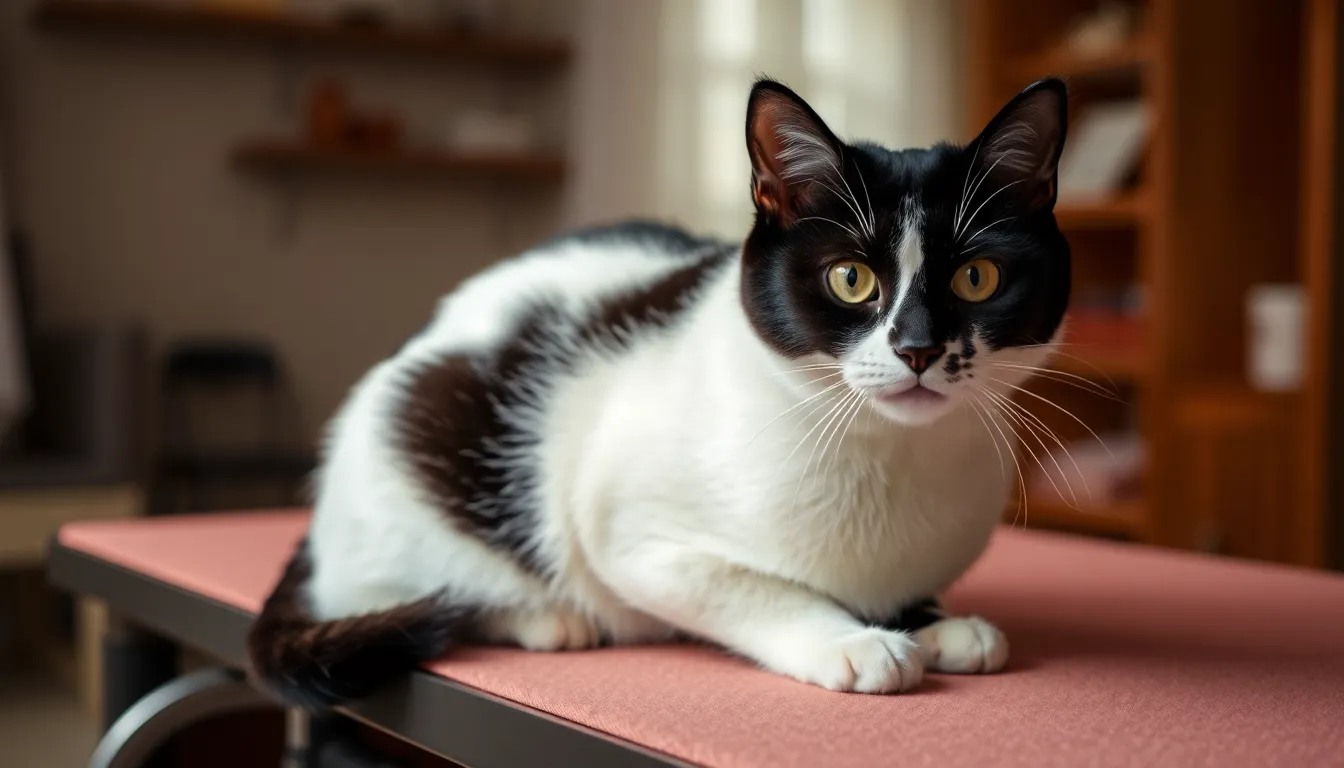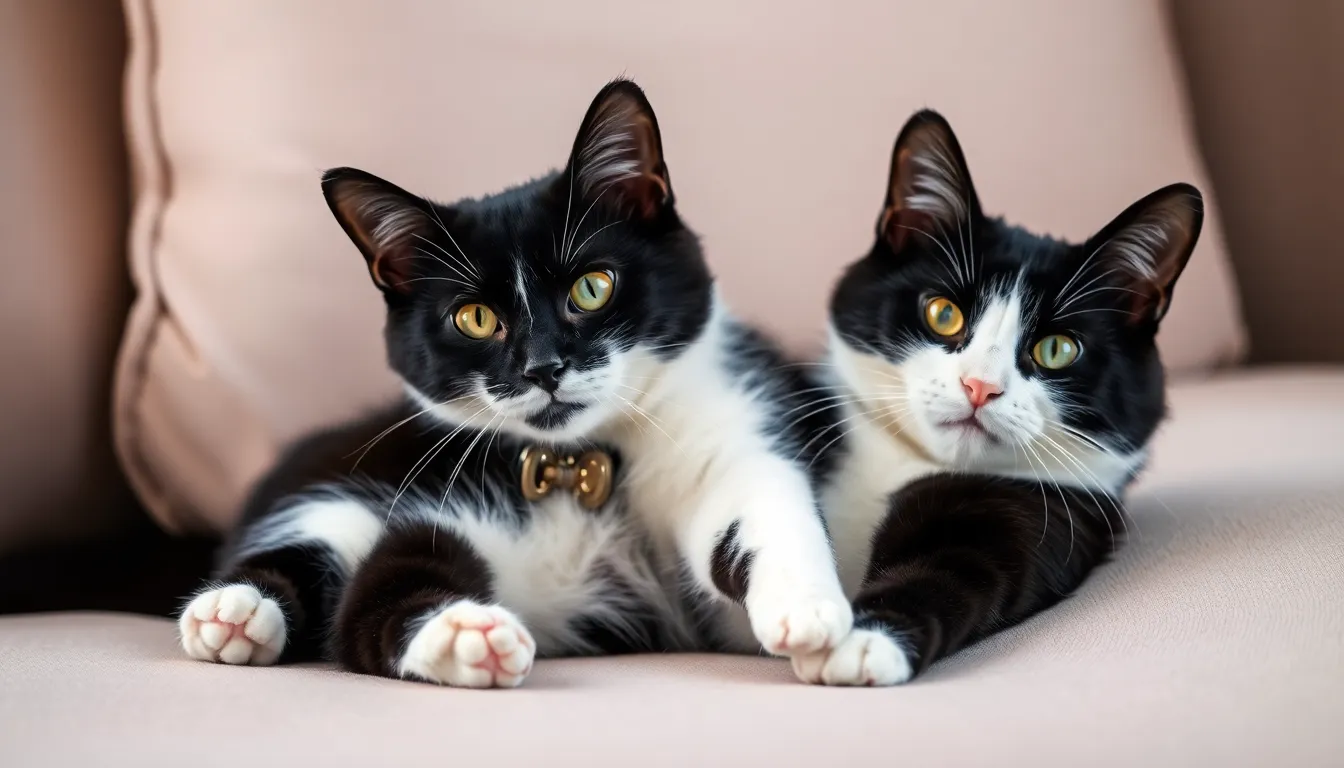
Black and White Cat Breeds: 15 Stunning Tuxedo Cats You Need to Meet
Share
Black and white cats capture our hearts with their striking appearance and undeniable charm. These dapper felines look like they're dressed for a formal event, sporting what appears to be a perfectly customized tuxedo complete with a crisp white shirt front and elegant black coat. It's no wonder we can't resist their sophisticated appeal.
What's truly fascinating is just how common these chromatic kitties are in our industry. Around 75% of all cats worldwide display black and white coloring, making them one of nature's most popular color combinations. Whether they're sporting the classic tuxedo pattern with a mostly black body and white chest, or showing off the playful "cow cat" look with irregular patches scattered across their coat, these bicolor beauties never fail to make a statement.
From mixed breeds to purebred Maine Coons and Oriental Shorthairs, black and white cats appear across many breeds, each bringing their own unique personality and charm to families everywhere.
Understanding Black and White Cat Patterns
Black and white cats display distinct coat patterns created by the white spotting gene, which ranges from low-grade to high-grade variations. Each pattern creates unique markings that distinguish these felines from one another.
Tuxedo Pattern
Tuxedo cats showcase a predominantly black coat with white patches on their chest, belly, and paws, creating the appearance of formal wear. Almost all tuxedo cats display white whiskers contrasting against their typically black fur, while their eyes tend to be green or yellow. This pattern represents a low-grade white spotting variation, where white markings appear in exact areas while black dominates the majority of the coat.
The tuxedo pattern can occur in both short-haired and long-haired cats, and even hairless breeds like the Sphynx carry this coloration on their skin. Multiple purebred cats commonly display tuxedo markings, including Maine Coons, British Shorthairs, Scottish Folds, American Shorthairs, and Turkish Angoras. Mixed breed domestic cats also frequently exhibit this classic pattern.
Owners often describe tuxedo cats as energetic, social, and affectionate, though these personality traits aren't scientifically correlated to coat color. Famous tuxedo cats throughout history include Sylvester from Looney Tunes, Felix the Cat from 1920s silent films, and Figaro from Disney's Pinocchio.
Bicolor Pattern
Bicolor patterns cover various combinations where white appears alongside another primary color, most commonly black. The white spotting gene determines the amount and distribution of white markings across a cat's coat, creating patterns that range from single small patches to extensive white coverage.
White patches typically appear first on a cat's chest and belly, followed by the front paws. A white spotting scale measures the degree of white present, categorizing patterns from low-grade spotting like the locket pattern (a single small white chest patch) to high-grade patterns seen in breeds like the Turkish Van.
Beyond traditional black and white combinations, bicolor cats can display orange, silver, grey, and tabby variations with white markings. These patterns can manifest in any mixed breed cat or purebred that carries the bicolor gene, making them widespread across feline populations worldwide.
Cow Pattern
Cow cats, also known as piebald or reverse tuxedo cats, feature irregular patches of black and white distributed across their coat in a distinctive dairy cow appearance. These cats often display primarily white coats with large black spots, sometimes creating a mask-like appearance around the face.
Alternative names for this pattern include Moo Cats, Harlequins, and Magpie cats, though most tend to be shorthaired varieties. The piebald markings provide evolutionary advantages by helping cats camouflage in patches of light and shadow, making hunting more effective for these mixed breed felines.
Cow pattern cats can belong to any breed, though they're most commonly found in mixed breed populations. Their unique markings make them easily recognizable and popular among cat enthusiasts who appreciate their quirky, distinctive appearance.
Popular Black and White Cat Breeds

Several distinguished cat breeds showcase the classic black and white coloration that captivates cat enthusiasts worldwide. Each breed brings unique characteristics that complement their striking bicolor coats.
Maine Coon
Maine Coons represent gentle giants in the cat industry with their impressive size and luxurious double coats. Males can exceed 20 pounds while maintaining their easygoing social nature that thrives on regular interaction and environmental enrichment. These cats display their black and white patterns beautifully through their dense coats and distinctive tufted ears.
| Maine Coon Characteristics | Details |
|---|---|
| Weight | 10-25 pounds |
| Height | 10-16 inches |
| Coat Type | Long double coat |
| Energy Level | Medium |
| Life Expectancy | 9-15 years |
Born and bred in America, Maine Coons have gained popularity worldwide for their curious nature and affectionate yet independent disposition. Their thick coats require regular brushing sessions to maintain their majestic appearance, particularly when displaying black and white colorations.
Persian
Persian cats showcase their black and white patterns through luxurious long coats that require important grooming commitment. These pugnosed felines trace their ancestry to Turkish Angoras and display calm, gentle temperaments that make them ideal lap cats. Their round sweet faces contrast beautifully with bicolor patterns, particularly the classic black and white combination.
Persian cats prefer elevated perches where they can survey their surroundings while maintaining their regal composure. Multiple brushing sessions each week become essential for keeping their long coats manageable, especially when maintaining the contrast between black and white fur sections.
| Persian Cat Features | Specifications |
|---|---|
| Weight | 7-12 pounds |
| Height | 10-15 inches |
| Coat | Long, luxurious |
| Energy Level | Low |
| Life Expectancy | 10-17 years |
Scottish Fold
Scottish Folds capture attention with their distinctive folded ears that create an owlish appearance, particularly striking when combined with black and white coloring. These cats form strong bonds with their families and display affectionate, adaptable personalities that make them excellent companions. Their prominent yellow or green eyes create stunning contrast against black fur with white markings.
Available in both longhaired and shorthaired varieties, Scottish Folds can display various coat patterns including the popular tuxedo coloring. Unfortunately, their signature folded ear trait links to a genetic mutation that can cause painful conditions such as osteochondrodysplasia, requiring careful breeding practices.
Sweet and calm by nature, Scottish Folds crave pets and affection from their families while maintaining their playful intelligence. Their round soulful eyes and unique ear shape make them instantly recognizable, especially in black and white colorations.
Mixed Breed Cats
Mixed breed cats represent the majority of black and white felines we encounter, displaying incredible variety in their coat patterns and physical characteristics. These cats showcase the variable expression of the white spotting gene, creating patterns ranging from minimal white markings to nearly complete white coverage with black accents.
Most black and white cats in homes and shelters are mixed breeds, each displaying unique combinations of size, temperament, and marking patterns. Their genetic diversity produces fascinating variations in how the black and white colors distribute across their coats, from precise tuxedo patterns to irregular cow cat markings.
These cats often exhibit low grades of white spotting patterns, particularly visible in kittens as they develop their adult coloration. Mixed breeds provide excellent companionship while showcasing the full spectrum of black and white coat possibilities without the health concerns sometimes associated with exact purebred lines.
Characteristics and Traits

Black and white cats possess distinctive physical attributes and personality traits that set them apart from other feline colorations. Understanding these characteristics helps us appreciate what makes these bicolor companions so captivating.
Physical Features
Black and white cats display remarkable coat pattern diversity created by the white spotting gene. The classic tuxedo pattern features a predominantly black body with white markings on the chest, paws, and sometimes belly, creating the formal appearance that gives these cats their name. Most tuxedo cats have white whiskers that contrast beautifully against their typically black fur.
Bicolor patterns range across a white spotting scale from low-grade to high-grade markings. Low-grade white spotting includes the locket pattern featuring a single small white patch on the chest, while high-grade patterns cover the Van pattern with color limited to the head and tail only. Medium-grade patterns include the standard bicolor with equal ratios of white to black coloring.
Cow cats present irregular patches of black and white across their entire coat, earning their nickname from the resemblance to dairy cattle markings. These piebald cats showcase more random white distribution compared to the structured tuxedo pattern. Size variations depend on the exact breed, with Maine Coons reaching medium to large proportions while Oriental Shorthairs maintain sleeker, more compact builds.
Personality and Temperament
Tuxedo cat owners anecdotally report that their cats exhibit friendly, easygoing temperaments even though no scientific correlation between coat color and personality traits. These cats are frequently described as playful, talkative, loyal, and displaying doglike behaviors in their interactions with humans.
Most black and white cats demonstrate low aggression levels and integrate well with other household cats, particularly when raised together from kittenhood. Owners note that tuxedo cats tend to be energetic, social, and highly affectionate companions. But, one anecdotal study suggested that black and white cats might show slightly more aggression during handling at home and veterinary visits compared to other colorations.
The personality traits we observe in black and white cats are shaped primarily by their upbringing and breed characteristics rather than their coat coloring. Each cat's individual temperament develops through early socialization experiences and genetic predispositions from their exact breed lineage.
Eye Color Variations
Black and white kittens are born with blue eyes that typically fade to different colors as they mature into adults. Most develop green, gold, or yellow eyes that create striking contrasts against their bicolor coats. The transformation usually occurs during the first few months of life as pigmentation develops.
A small percentage of black and white cats retain their blue eyes into adulthood, creating especially dramatic and sought-after appearances. These blue-eyed adults are relatively rare and highly prized among cat enthusiasts for their distinctive looks. The eye color inheritance operates independently of the coat pattern genes, allowing for various combinations across different individuals.
Green eyes appear most commonly in adult black and white cats, followed by golden and yellow variations. The exact eye color that develops depends on genetic factors inherited from both parents and isn't predictable based solely on the coat pattern or parent eye colors.
Black and White Cats in Popular Culture

Black and white cats have captured hearts and imaginations across entertainment media for decades. Their distinctive appearance and charming personalities make them perfect candidates for memorable characters in films, television shows, and literature.
Famous Fictional Characters
Cartoon characters featuring black and white cats dominate popular entertainment with iconic personalities that span generations. Felix the Cat emerged in 1919 as a silent film era character created by Pat Sullivan and Otto Messmer, featuring a fully black body with a partially white face and his signature grin. Sylvester James Pussycat Sr. became famous through Looney Tunes and Merrie Melodies cartoons, constantly chasing Tweety, Hippety Hopper, and Speedy Gonzales with his distinctive tuxedo markings.
Tom from The Tom and Jerry Show represents another classic animated tuxedo cat, while Dr. Seuss's Cat in the Hat stands as one of literature's most beloved monochrome felines. Broadway audiences recognize Mr. Mistoffelees from the musical Cats, and Penelope Pussycat appears as a non-speaking character in Warner Bros' Looney Tunes animated shorts.
Video game characters also feature prominent black and white cats across popular franchises:
| Game Series | Character | Description |
|---|---|---|
| Final Fantasy VII | Cait Sith | Robotic cat with tuxedo markings |
| Animal Crossing | Rover | Friendly feline villager |
| Persona 5 | Morgana | Cat-like phantom thief |
| Sonic the Hedgehog | Big the Cat | Large purple and white cat |
| Industry of Warships | Unsinkable Sam | Historical ship cat |
Movies frequently showcase tuxedo cats in memorable cameos, including The Nine Kittens of Christmas (2021), Luca (2021), John Wick Chapter 3 (2019), Les Misérables (2012), and Raiders of the Lost Ark (1981).
Celebrity Cats
Real-life famous tuxedo cats have made their mark in history through extraordinary circumstances and achievements. Oscar, also known as Unsinkable Sam, survived three major WWII shipwrecks between May and November 1941, earning legendary status among maritime cats. Simon served as the ship's cat on the Royal Navy sloop-of-war HMS Amethyst and received burial with full naval honors for his service.
Roderick holds the unique distinction of being the only cat reported to have climbed Mt. Everest, showcasing the adventurous spirit often associated with tuxedo cats. Political aspirations reached new heights in 2012 when Tuxedo Stan ran for mayor in Halifax, Canada, inspiring the Halifax City Council to award a large grant for a low-cost spay and neuter clinic even though not winning the election.
Presidential history includes Socks, the Clinton family's tuxedo cat who lived in the White House, bringing national attention to black and white cats during the 1990s. Historical figures including William Shakespeare, Ludwig van Beethoven, and Sir Isaac Newton reportedly owned tuxedo cats, though definitive proof remains elusive.
These celebrity cats demonstrate the enduring appeal and remarkable nature of black and white felines, cementing their place in both popular culture and historical significance.
Caring for Your Black and White Cat

Black and white cats require the same fundamental care as any feline companion, though their distinctive coat patterns present exact considerations. Understanding their unique needs helps ensure these striking cats remain healthy and happy throughout their lives.
Grooming Requirements
Short-haired black and white cats benefit from weekly brushing sessions to remove loose fur and distribute natural oils across their coat. Long-haired breeds like Maine Coons and Persians require daily brushing to prevent matting and tangling, particularly in areas where black and white fur meet.
White fur patches show dirt and debris more readily than black sections, making regular grooming essential for maintaining their pristine appearance. Focus extra attention on white chest areas and paws, which accumulate visible dirt faster than darker regions.
Bathing becomes necessary only when cats get exceptionally dirty or sticky substances cling to their fur. Use lukewarm water and cat-exact shampoo to avoid skin irritation. The contrast between black and white sections makes any residual soap highly visible, so thorough rinsing prevents dull patches from appearing.
Regular nail trimming every 2-3 weeks keeps claws healthy and prevents furniture damage. Check ears weekly for wax buildup or signs of infection, cleaning gently with veterinarian-approved answers when needed.
Health Considerations
Black and white cats live 13-20 years on average, with their lifespan primarily determined by breed, lifestyle, and overall healthcare rather than coat color. Mixed breed black and white cats often experience fewer genetic health issues compared to purebreds due to their diverse genetic backgrounds.
Some studies suggest black and white cats may show increased sensitivity during handling and veterinary visits, though proper socialization from kittenhood typically minimizes this tendency. Creating positive associations with touch and medical examinations helps reduce stress-related behaviors.
White fur patches can make these cats more susceptible to sunburn, particularly on ears, noses, and other sparsely furred areas. Indoor living or supervised outdoor time during peak sun hours protects against UV damage and potential skin cancer development.
Certain purebred black and white cats inherit breed-exact health concerns. Scottish Folds may develop osteochondrodysplasia affecting joints and cartilage. Persian cats face increased risk of polycystic kidney disease and breathing difficulties due to their flat facial structure.
Regular veterinary checkups every 6-12 months allow early detection of health issues. Maintain current vaccinations, provide dental care, and monitor weight to prevent obesity-related complications that affect cats regardless of their coat color.
Choosing the Perfect Name

Black and white cats offer endless naming possibilities thanks to their distinctive coat patterns and sophisticated appearance. Their tuxedo-like markings create natural inspiration for elegant names like Tux, Tuxie, or the classic Mr. Mistoffelees from musical theater fame.
Color ratio plays a crucial role in selecting the ideal moniker for your feline companion. Cats with prominent white chests suit distinguished names that reflect their formal appearance, while those with scattered white spots throughout their black fur inspire playful options like Pepper, Domino, or Speckles.
Pattern-based names celebrate the unique markings that make each black and white cat special. Popular choices include Oreo for cats with distinct black and white sections, Panda for those with white faces and dark ears, and Chess for felines with geometric-looking patches.
Creative owners often draw inspiration from famous black and white objects or characters in popular culture. Names like Orca, Penguin, Zebra, and Yin Yang reflect the striking contrast of their coat colors, while Salt and Pepper works perfectly for bonded pairs.
Female black and white cats shine with elegant names that match their sophisticated appearance. Options like Luna, Cleo, Zara, and Ebony emphasize their mysterious beauty, while playful choices such as Minnie, Gigi, and Peaches highlight their charming personalities.
Unique naming approaches set your black and white cat apart from typical feline monikers. Galaxy, Pixel, and Ziggy offer modern alternatives, while Rorschach appeals to art enthusiasts who appreciate the ink blot patterns in their cat's markings.
Traditional themes provide timeless naming options that never go out of style. Weather-inspired names like Stormy, Shadow, and Moon capture the dramatic contrast of their coloring, while texture-based options such as Marble, Smoke, and Ash reflect their sophisticated coat variations.
Pop culture references create memorable names that spark conversation and connection. Famous tuxedo cats from entertainment, including Sylvester, Felix, and Tom, offer classic choices that celebrate the rich history of black and white felines in media.
Conclusion
Black and white cats continue to capture our hearts with their timeless elegance and endearing personalities. Whether you're drawn to the classic tuxedo pattern or the playful cow markings these felines offer something special for every cat lover.
Their widespread availability means finding your perfect black and white companion shouldn't be difficult. From purebred Maine Coons to lovable mixed breeds these cats bring joy and character to millions of households worldwide.
We believe black and white cats represent the perfect blend of beauty and personality. Their distinctive coats paired with their generally friendly nature make them excellent choices for first-time owners and experienced cat enthusiasts alike.
Frequently Asked Questions
What percentage of cats worldwide are black and white?
Approximately 75% of all cats worldwide have black and white coloring, making this one of the most common and popular color combinations found in felines across different breeds and mixed breeds.
What causes the black and white patterns in cats?
Black and white patterns in cats are created by the white spotting gene, which varies from low-grade to high-grade expression. This gene determines how much white appears on the cat's coat and where it's distributed.
What's the difference between tuxedo and cow pattern cats?
Tuxedo cats have predominantly black coats with white patches on the chest, paws, and face, resembling formal wear. Cow pattern cats have irregular black and white patches distributed randomly across their body, similar to dairy cow markings.
Do black and white cats have specific personality traits?
Black and white cats are generally friendly, playful, and social. However, their personality traits are shaped more by their upbringing and breed characteristics than by their coat color. Some anecdotal evidence suggests they may be slightly more energetic.
What eye colors do black and white cats have?
Black and white kittens are born with blue eyes, which typically change to green, gold, or yellow as they mature. Blue-eyed adult black and white cats are particularly rare and highly sought after.
Which cat breeds commonly have black and white patterns?
Many breeds showcase black and white coloring, including Maine Coons, Persians, Scottish Folds, and Oriental Shorthairs. However, the majority of black and white cats are mixed breeds with diverse coat patterns and characteristics.
Do black and white cats require special grooming care?
Black and white cats need regular grooming based on their coat length. Short-haired cats benefit from weekly brushing, while long-haired breeds require daily grooming. White patches show dirt more readily, requiring extra attention during grooming.
What's the average lifespan of black and white cats?
Black and white cats typically live 13-20 years. Mixed breeds often experience fewer genetic health issues compared to purebreds, though regular veterinary checkups are essential for maintaining their health throughout their lives.
Are there famous black and white cats in popular culture?
Yes, many iconic characters feature black and white cats, including Felix the Cat, Sylvester from Looney Tunes, and Tom from Tom and Jerry. Real-life celebrity cats include Unsinkable Sam and Socks, the Clinton family's cat.
What are good names for black and white cats?
Popular names include elegant options like Tux and Domino, playful choices such as Oreo and Panda, and cultural references from famous black and white characters. Names often reflect their distinctive tuxedo-like or cow-pattern markings.
